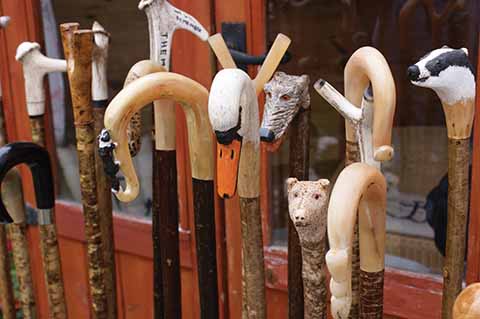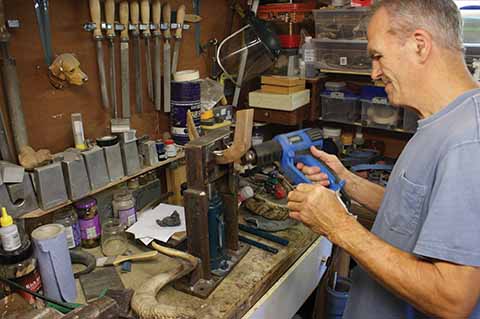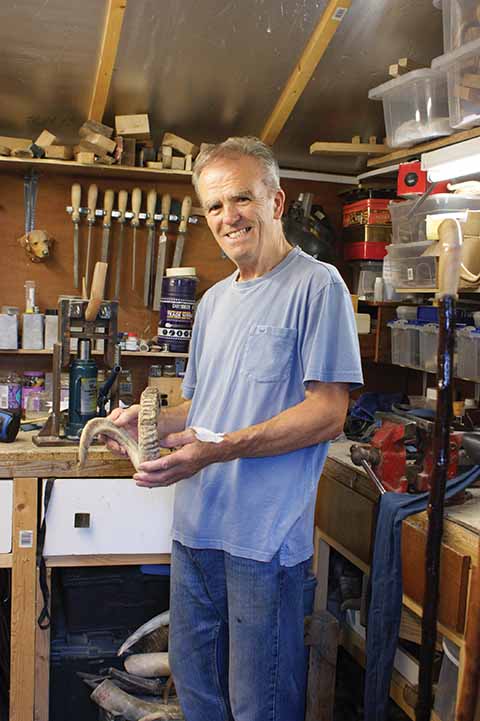Dorset crafts – By horn and by crook
David Callaghan visits stickmaker and horn-dresser Brian Waters
Published in May ’19
It began as a walk in Upton Wood, simple exercise for Nell, the dog he had been bought after back problems forced him to give up building work. As he had done many times before, he picked up a stick. But that day, instead of leaving it, he brought it home and decided to carve it.
Nearly a decade later, what was little more than a whim has turned into a life-enhancing new avenue of creative pursuit for Brian Waters, whose Dorset Sticks brand provides an outlet for his shepherd’s crooks and cleeks, walking sticks, shooting sticks, thumb sticks and shillelaghs.
‘To this day I can’t tell you why I had to work that holly stick,’ says Brian in the well-organised chaos of his recently tidied garden workshop. ‘It felt right and I had this idea I wanted to carve it, so I went online and found some videos. What I came across were mainly American videos and they’re into this fantasy stuff, which is why I ended up carving a wood spirit character. I couldn’t tell you why there’s a snake coiled around the end, but there is.
‘I’d worked with wood for years as a builder and carpenter, although it doesn’t necessarily follow that I’d be a good stickmaker, but carving the stick struck a chord with me. I’ve always felt very protected in woods, even in a full storm. I’ve an affinity with woodland, a belief that I’m safe there.’

Some of Brian’s sticks. The swan head stick is for one of Brian’s students who rescues swans – ‘He couldn’t write his address down quick enough when I told him I was making it.’
Further exploration of stickmaking revealed a small but dedicated band of British artisan craft workers, concentrated mainly where horned sheep breeds are found and Brian was drawn to the particular skills of the horn-dresser, who shapes horn to create a decorative handle, thumb-notch or crook for a stick.
First, though, Brian set about mastering the working, shaping and finishing of wooden sticks. ‘I’m still learning new things every day even about the basics, but I’m very glad I held off from going into horn-dressing sooner than I did – I wasted enough good horn as it is.’
He works mainly with sheep horn, but also cow, goat and even black buffalo. The thermoplastic qualities of horn – as opposed to antler, which is bone – mean it can be worked when heated and hardens on cooling. When compressed, or bulked, to remove the cavity and bent into line, horn is incredibly tough, perfect for a traditional shepherd’s crook for instance.
‘Horn is made of keratin, like hair and fingernails,’ explains Brian. ‘It is organic and, interestingly, once it has been boiled and worked into line, if it were to be boiled again it retains a “memory” of what it once was and will try to return to that shape.’
Bulking horn is a lengthy and precise process learned only by experience. There is zero margin for error. There is no certainty as to what temperature is perfect for working horn and the application of force – Brian uses compressed oil and an array of hand-made jigs – is done in a very controlled way so as not to crack or snap the horn. ‘It must be right, that’s all there is to it,’ he says. ‘You have to learn when it feels right and get used to how much pressure you can apply to bend and squash the horn. If it goes wrong, you’ve wasted the horn. I get mine from an abattoir and while there’s no shortage of rubbish horns, the good ones get expensive.
‘I joined Hants and Dorset Stickmakers, where I met my friend, Charlie Walker. He showed me the basics of horn-dressing and it just went on from there. You don’t get many youngsters in stickmaking as it’s mainly retired folk who have the time to give it, but there are a few that learn the ropes and hopefully will come back to it in later life.’

Brian heats the bulked horn so that he can work on it, about an inch at a time. It’s painstaking, time-consuming work – too cool and the horn won’t respond, too hot and it becomes brittle and cracks.
All of Brian’s sticks have a practical application – they can all do a job – in line with traditional standards set by the British Stickmakers Guild, of which Brian is an Executive Committee member. He reckons interest in the craft is on the rise. ‘Regional shows can feature a few hundred sticks from a few dozen makers but if sales of sticks and stickmaking equipment are anything to go by, more people are getting into it. Mind you, showing can be a brutal business. The first thing judges do when they pick up a stick is look for straightness, then they swing it to check if it is balanced and anything they don’t like is set aside before they even look at the workmanship or the carving.
‘A perfect stick is a rare thing but I’ve seen a few. I can pick up sticks at a show and know who made them. My trouble is that I can have anything up to ten sticks on the go at any one time, whereas the champion stickmakers only do one at a time. Maybe if I was younger and more energetic I’d pursue it harder, but I pick up the odd second or third place and I’m happy with that. The most important thing is that I absolutely love what I do.’
Most of the wood Brian uses is hazel, although he also works with holly, blackthorn and, on occasion, hawthorn. Stickmakers like overstood wood – unmanaged coppice – because it grows straight and provides sticks of an ideal weight, about an inch-and-a-quarter in diameter at the top with a slight taper. ‘They’re also known as sun-shoots and we have a few landowners who will invite us onto their land to cut sticks. We get invited back as we always tidy up, push loose ends back in the soil, that kind of thing – it should appear as if we’d never been there. I’m as happy out in the woods cutting new sticks as I am in the workshop making them.
‘I don’t really like selling my sticks, but I do it to keep going as costs can mount up – not that I charge properly for my time, you understand, as I have to work to a standard. I tried working to a price for a while and really didn’t like what I made. What stick you need depends on what you want it for but it should feel comfortable – you’ll know when you’ve got the right one. It’s very personal.’
www.dorsetsticks.com


